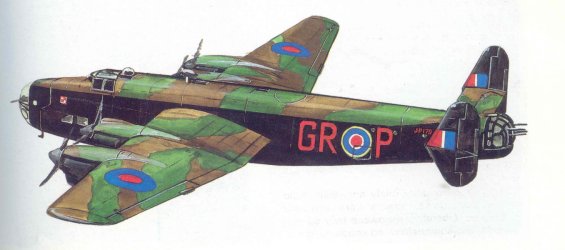
An English Halifax bomber
Allied Airdrops for the Fighting Warsaw
Already in June of 1940, the British government called into being a secret organization called SOE (Special Operations Executive). It was designed to revive and step up the underground resistance movement in the countries under Nazi occupation. A Polish section of the SOE was soon established.
Special air forces were submitted to the SOE in order to ensure the provision of necessary weaponry and equipment for the armed underground. In August of 1940 the RAF Air Station was established in Newmarket, Middle England, where a special unit - No. 1419 Flight - was formed.
In August of 1941, No.138 Special Duties Squadron took over the tasks of the Flight. In September of 1941 the squadron was joined by three Polish crews. From that moment on, the Polish pilots commenced their special operations service that was to last nearly 4 years. All the pilots were volunteers and had essential operational and combat experience (30 combat flights on joining the unit).
On 1st April 1943, a Polish flight - consisting of 6 (+1 extra) crews plus maintenance crew - was formed as a part of No. 138 Squadron. The Flight was equipped with 3 Halifaxes and 3 Liberators, and numbered 301 to commemorate the bombing squadron of the same number which had suffered substantial losses during the bombing raids over the Third Reich and been disbanded as a result.
During the unit's stay on the territory of England, the SOE carried out 103 operations in support of the Polish Underground, 72 of which proved successful. 194 members of the Polish Cichociemni special forces, along with 80 tons of supplies, were redeployed. Ten planes were lost in the process.
As the passage via the northern route grew more difficult and dangerous (in September of 1943 eight planes were lost during night-time operations), in the autumn of 1943 the Flight was moved to Tunis, and then - in December of 1943 - to the Campo Casale airport near Brindisi, Italy. The SOE air forces kept growing; the Polish flight received an identification number 1586 and became a part of No. 138 Squadron of 334 Wing of the RAF Special Duties Forces.
The transfer of the base to the south proved to be the right choice. Initial setbacks notwithstanding, in April and May of 1944 104 people as well as 172.5 tons of supplies were redeployed to Poland - twice as much as during the previous 3 years of operating from the United Kingdom. Five planes were lost during that period.
The Polish section stationed in Italy operated effectively for the whole year 1944. 620 combat flights to Poland were carried out over that time, 290 of which (47%) proved successful. They delivered 152 jumpers and 362 tons of supplies. Moreover, they sent to Poland 194,400 dollars in gold, 10,433,400 dollars in banknotes and 43,000,800 PLN in banknotes. Their losses amounted to 48 four-engine planes.
The SOE used two types of bombers for night-time raids: Halifaxes and Liberators.
An English Halifax bomber had the following parameters:
Technical data: 4 Rolls-Royce Merlin in-line engines 1,260 kM each; dimensions: wing span 30.12 m, length 21.82 m, height 6.32 m, wing area 116 m2; empty weight 17,350 kg; operational weight 24,675 kg; maximum operational weight: 27,340 kg; performance: maximum speed: 451 km/h, ceiling 7,315 m, typical range 4,800 km, maximum range 5,470 km; weapons: bomb load: 5,900 kg of bombs carried in the bomb bay in the fuselage (about 6.70 m long) and 12 in wing bays; crew: 7 people.
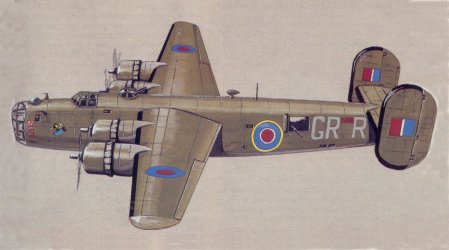
An American B-24 Liberator bomber
An American B-24 Liberator bomber had the following parameters:
Technical data: four-star 14-cylinder Pratt-Whittney "Twin-Wasp" R-1830-43 engines, power 1,200 KM (833 kW) each; dimensions: wing span 33.55 m, length 20.52 m, height 5.49 m, wing area 97.4 m2 , empty weight 17,200 kg, total weight 32,300 kg; performance: maximum speed 480 km/h, minimum speed 140 km/h, rate-of-climb at 3,200 m :10 min, ceiling 9,700, typical range 3,700 km, maximum range 4,500 km; weapons: 4 movable positions for 2 twin-guns calibre 12.7 mm, 3 machine guns calibre 7.7 mm, 5,800 kg of bombs; crew: 7-8 people.
The insurgents joined the fight on August 1st with a substantial shortage of weapons and ammunition. The situation became critical after the first few unsuccessful attacks on German installations, during which the troops hoped to replenish their supplies with the weapons captured from the enemy.
On 2nd August 1944, the AK (Home Army) Commanding Officer, General Tadeusz Bór-Komorowski, cabled the commanding officer of the Polish Air Force base in Brindisi for help. Given the alarming state of ammunition supply for kb, km, pm and anti-tank weapons, he asked for airdrops to be delivered to the small Ghetto, the filters, Plac Niepodległości, Madaliński region , Kercelak and the Jewish Cemetery. All those places were to be marked at night with the agreed-on signals (an arrow).
The reception of the telegrams triggered an immediate response and the preparations to aid the fighting Warsaw started. The distance between them and Warsaw, en route the Adriatic, Yugoslavia and Hungary, was about 1,400 km. Numerous positions of anti-aircraft artillery covered the route, with German night fighter planes hunting for the bombers.
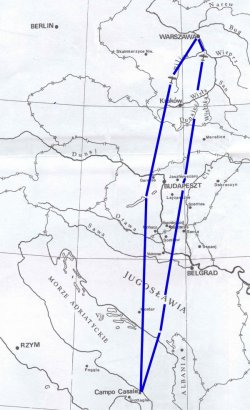
The air route of airdrop planes heading for Warsaw
Initially, the aircraft did not get a permit to embark on the flight to Warsaw due to unfavourable weather conditions. The commander of the MAAF - Air Marshal John Slessor - was the one to refuse the permission.
In the late evening of August 3rd, 14 machines - 7 Polish and 7 RAF crews - were completing the preparations for going in aid of the fighting Warsaw. Just before the start an order came to drop the supplies not over Warsaw, but over some other regions of Poland. The four Polish crews (3 Liberators and 1 Halifax) decided - with a quiet approval of the Base Commander, Major Jan Jadźwiński, and the Flight Commander Major Eugeniusz Arciuszkiewicz - to carry out airdrops in the Warsaw region. Each aircraft embarked on a mission equipped with 12 waterproof metal containers, which were 2.5 m long with a diameter of 1 m, bearing a resemblance to a heavy bomb and weighing over 160 kg. Altogether a bomber could carry 2 tons of supplies: Sten guns, machine guns, anti-tank weapons, rifles, grenades and ammunition. Some of the ammunition was German in origin and fitted the weapons captured by insurgents.
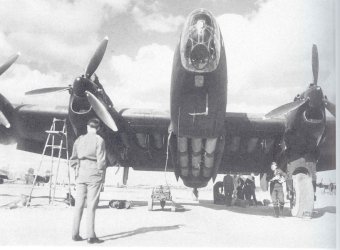
A bomber ready to take off at the Campo Casale airport
On the night of 3rd/4th August 1944, three crews under the command of Captain Stanisław Daniel, Lieutenant Tedeusz Nencki and Pilot Officer Stanisław Kleybor carried out successful airdrops in Wola cemetery region, the operational area of "Radosław" group. The supplies were dropped between 0:48 and 01:43 am.
Warrant Officer Jan Cholewa, the pilot of Halifax JP-251 "P" under the command of Warrant Officer Henryk Jastrzębski, thus recalls the events:
It's been four days since the Polish Radio from London started to transmit the song "With the smoke of fires." It's been for days that Warsaw has been pleading for help - for airdrops and parachutists - and still it stands alone. Meanwhile, our parachutists are fighting near Arnhem, and we? - what an irony of fate - we fly to aid insurgents in Northern Italy.
Although it's still half an hour before the clearance, the check-in hall is filled to capacity; all crews are there. It has been crowded so for four days now. We beg for the permission to fly over the city, while they plead and wait for the airdrops.
A few minutes before the clearance starts, in comes Major Arciuszkiewicz, the commander of No.301 Squadron. The room gets as silent as the grave. We fix our gaze on the commander's face, as though hoping to decipher the answer to what we've been awaiting in vain for four days.
About forty years old, dark-haired and over five feet tall, Major Arciuszkiewicz takes the podium and, studying for a moment the map of Europe that covers the whole front wall of the room, he turns to us and asks for silence in a voice filled with emotion.
'Hmm!... Our chief seems awfully lost in thoughts today,' someone whispers on the side. 'Did he fail to notice how quiet it's been in here since the moment he entered the room?'
'Gentlemen,' says Major, 'who'd like to go to Warsaw?'
The uproar that arises is ear-splitting. We spring out of our chairs and dash to the commander. 'Major! We'll go! - Major! We know Warsaw well! We'll go! - Sir! We want to go!' Exclamations like these can be heard now and again above the racket.
Major Arciuszkiewicz raises his hand and asks for quiet; out throats croaky from all that shouting, we slowly return to our seats.
'Gentlemen! The flight is very risky and long, about 1,400 km, and so the three oldest crews will fly today.'
Thanks to this resolution, our crew found itself among the lucky chosen ones.
'My friends,' continued Major, 'taking advantage of the absence of the English, I'd like to mention that the airdrop site is on the Jewish Cemetery; we raid from the direction of Puszcza Kampinoska or the Raszyn radio station. You will receive the exact location of the cemetery, as well as the signal signs, from a navigation officer after the clearance. That's all I can tell you for now since we lack information concerning the positions, numbers and quality of the Nazi anti-aircraft defence both in that region and in Warsaw as such. You'll have to find out by yourselves. Please remember that this is to be the first airdrop for this city, carried out by the aircraft of the RAF's special duty squadrons. You will be the ones responsible for whether we continue to fly to Warsaw or not. Oh! - and just to pull the wool over their [the English] eyes, the rest of the aircraft will go to airdrop locations in the middle and middle-west parts of the country.
At that moment, the English officers, led by the Base Commander, enter the hall. The standard clearance begins, like before any other combat flight. I doubt whether any of us is paying attention to what individual section leaders are saying because everyone's thoughts are already in Warsaw.
'Jurek!' a whisper from behind reaches my ears. 'Remember! Once you're back, you have to tell that the city's defenceless.'
After the clearance we head for the airport, with only the navigators staying behind to plan the flight. The place is full of commotion, our mechanics bustling around the machines like doctors around a patient. Our foreman checks for what seems like a hundredth time the supply of fuel, oil, glycol, ammunition, and dozens of other things which can be found on a plane, and which all together determine whether the flight proves successful or not. We may as well go and have supper; the mechanics will make sure that the planes are as faultless as though they were to fly them personally. After all, the Polish mechanics are second to none in the RAF.
After supper we take some sandwiches and orange juice, prepared for us by cooks, and head for the quarters. Meanwhile, our Emilio - meaning our deck mechanic, Senior Sergeant Emil Szczerba, a man of medium height, dark hair and a cavalryman's legs - has gone to issue chocolate and sweets for the whole crew. A lorry draws up in front of the building; we clamber on and set off to the airport. Once we're inside, the regular teasing starts, with everyone trying to put the fear of God into the fellows from other crews. Those with weaker nerves turn pale and ask to stop the silly jokes and let sleeping dogs lie.
The lorry draws up to our plane's take-off position. Smiles on their faces, the mechanics run up to us, take our parachutes and jumpsuits, and load them on board. The mechanics tend to act just like our mothers when sending their kids to school on their first day. It's an open secret that when we go to "war" - they stay up and wait for our return.
Groups of our regular spectators line the runway's side: doctors, orderlies and nurses from a nearby field hospital. Our foreman starts up the engines of the Halifax. We get on, try the engines and sign the book passed by the smiling foreman. It's time to taxi. With Liberator "V" in front of us, I slowly leave the position. The mechanics raise their thumbs up, as is their English custom, wishing us luck. We return the gesture.
We stop on the way; there's a line of machines before us, the first of which is just about to get on the runway. It takes off at exactly 9 pm. Another one rolls on the runway and takes off - every minute a huge Halifax gets on the runway and takes off.
I taxi on the runway, off we go!... The flight takes a seaward direction; it is long and hard as hell. Just as the finishing line of the runway draws dangerously near and one starts to sweat it that the plane will go flying straight to the sea, the machine detaches itself from the ground. Emilio lifts the undercarriage handle and, the wheels pulled in and blocked, he raises the flaps.
I take a 180 degrees turn, we go along the airport, catching a glimpse of another plane taking off down there, and of the audience waving us goodbye. Again a 180 degrees turn; we fly over the airport, leaving the town of Brindisi behind us, take a route towards Yugoslavia and go over the sea. It's 9:15 pm. Slowly we're gaining height.
The airport and its surroundings are fading in the fog. A tail gunner, Senior Sergeant Ruman - slightly built, medium height, blond hair - fires his machine guns. Down there, everything is enveloped by semi-darkness while before us massive clouds build up, against which the silhouettes of planes are clearly visible, illuminated by the last rays of the setting sun. The Yugoslavian shoreline comes into view; German artillery can be heard firing to our left, apparently one of ours has wandered off there, looking for trouble.
We are flying at 4,500 m. On our left there's a Liberator "V" , below us and level with us shreds of clouds drift by. I can hear Emilio telling the navigator that we are going upwind seeing that the clouds are drifting backwards. The navigator - Senior Lieutenant Kleybor, a handsome, dark-haired man of middle height - snorts with laughter into the microphone and says:
'Emil, don't be such a loser"
The first raindrops splatter against the window panes as we enter the clouds. At the same moment down goes the rain, as though someone showered us with bucketfuls of water. I turn on the windscreen wipers but to no avail. Uhm!... The water starts seeping down on my knees, what a pain! There is always something leaking! Ruman starts whining that he keeps getting a shock from the guns and that electricity sparks between the barrels. I'm not surprised; after all we can now see a halo of orange-yellow light around the propellers, too. Uh-uh! The sparks get between the wipers and the window frame, I touch the fuselage with my hand and it gives me one hell of a shock; the entire plane sparks with electricity. Even Staś Dubiel, our black-haired wireless operator, the only tall fellow in our crew, comes to join us because there is nothing he can catch on his radio other than some crackles.
Warrant Officer Jastrzębski, our pilot of medium height and stocky build, says that so far Łapichmurka seems to be right in his weather predictions, the only thing that's missing is some tu... - he never finishes the word because at that moment we get lifted upwards, the plane just rears up, the rudders are no use, we start to dance. Even rock'n'roll is nothing compared to the twists and turns of our machine that day. As though that wasn't enough, flashes of lightning blind us again and again.
'Damn it! My maps, pencils, compasses - Staś, come and help me get this stuff together!' Kleybor shouts at the wireless operator.
'Kleybor, how far to the Tatra Mountains?' Jastrzebski asks the navigator.
'Damned if I know, I hope we're still over Europe! Dubiel doesn't give me any positions, I can't see the stars, the compass is dancing just like this plane, so frankly I've no idea where the Tatra Mountains are.'
After half an hour of this hellish dance I am covered with perspiration and my legs are numb from fatigue. Oh! At last! I can feel that the plane starts to settle down, it even responds to the rudders. We get out of the clouds. Hell finally left behind, my only mementos are two blisters on my hands. Emilio is what I call a great guy, he fetches me a lit cigarette. We're in Poland!
'The Tatra mountains behind us!' the tail gunner exclaims.
I start descending, glimpse a small river below us; I take a new course given by the navigator, the little river turns out to be the Vistula river. Height, according to a radio-altimeter, is now 30 m. In front of us to the right the artillery is firing, right, we're as far as Kielce now. I remember - when on 3rd September 1939 I was at the Kielce Railway Station, there was this sole anti-aircraft cannon, firing at the German planes flying by. Now there are many more of them, and they fire at us. We pass the city from the left side, several floodlights search for us somewhere high in the sky while we fly at a height of a dozen meters or so. Kielce is far behind now. From time to time we pass over some farms, clumps of trees, villages; someone flashes a pocket torch at us. We go along some railway tracks. We fly over a small town and a railway station; it turns out we've passed Mszczonów. Down to the right we can see a glow in the sky; what could that be? It's Warsaw burning. We gaze at the flames that grow more distinct with every passing moment, now shooting up in the fountains of sparks, now dying down only to fly out again.
In front of us we can see a forest, it's Puszcza Kampinoska; the navigator gives me another course and points to a location from which to take this course. It's a path that cuts into the forest, a line of grey against the stretches of green. I go round the place and take a new course. The fires of Warsaw come into view once again. A Halifax silhouetted against the glow approaches the city. The navigator asks the dispatcher Sergeant Ilnicki, a man of average height, with black hair and a moustache á la Hitler, if the packages are ready to be dropped. 'OK,' replies Ilnicki a moment later.
Below us we can see Warsaw's first buildings and containers going to the ground as well as a Halifax turning right. I slow down, lower the landing gear and the flaps, and open the bomb doors; we're going at the speed of 130 miles. The cemetery is now in front of us.
'Drop it!' I can hear the navigator shout, and at the same moment the machine bops up. 'The containers are gone,' says the navigator.
Emilio retracts the landing gear and the flaps, we speed up.
'A few packages have landed on the street,' yells the tail gunner.
Several people run out to fetch them, a group of others can be seen coming from the opposite direction, shooting as the go. Tearing my eyes away from the flames I notice - oh horrors! - several cannons firing at us; luckily, they aim way too high. I turn right, pass over another railway tracks and some roofs; taking the left turn I get on the course and we head for the Tatra Mountains. Again, we fly over villages, with the flashes of torches flickering at us here and there. The blazes of Warsaw are now far behind us and yet everyone keeps silent. As we go over Kielce, the shooting starts anew, and, like before, they overshoot. We go over the Vistula and start ascending. Clouds lit by the lightning appear in front of us. This time Jastrzębski will sweat over them as he's been the one behind the steer since we left Warsaw. My knees are getting cold, no wonder - I forgot to wrap them with old newspapers. We enter the clouds and the same old hellish dance starts again. I watch the pilot, who seems all tired out, his face flushed.
'Heniek!' I say to him, 'why don't you try to go over the clouds, we've got enough fuel.'
Heniek begins his unhurried climb but how can you go up when the machine dances around like a staggering drunkard. One moment the altimeter shows 6,000 m, another moment it goes down to 5,500 m.
At long last we climb over the clouds and, oxygen masks covering our faces, reach an altitude of 6,500 m. The sky above us is clear and starry, while some 100 m below there's a sea of tumbling clouds. The sky in the east is turning red, could that be the sunrise already? So it is; the red rim of the sun's disc comes out slowly, the sky brightens. There's a sound of patter against the fuselage, as though someone threw peas or little rocks at it - oh! - there we go again, the plane bobs up. Heniek starts squirming nervously. The plane loses altitude, gains speed, goes up again. At this moment I can see little black clouds forming before us; it's the artillery left behind. Staś informs us through the microphone that we've just passed Szeged.
'That's some fast thinking, I knew it was Szeged without your help, no one else fires so well in this region,' replies Heniek.
Large and red, the sun comes out from behind the clouds; it's morning here, though down there the gloom still lingers, not to mention that rain. I wonder what kind of weather awaits us in the base: sunshine or rain. We can see two planes flying before us; the one closer to us is a Halifax, the one at the front I can't recognize since it's nothing more than a little line on the horizon. I guess, though, that it must be one of ours - who else would like to go out in the weather like this?
'Heniek! You may lose altitude now,' the navigator says to the pilot, 'we're over the sea.'
Uh-Uh! Again the artillery; shells are exploding all around us, and damn close, too. Heniek begins to lose altitude. In front of us - the sea! Two small ships are swimming towards us; sure enough they are flak ships, cutting through in our direction. We are at a height of 300 m, the airfield looms before us. The Halifax makes a final approach to the airport, another one is a letter "C" and asks for permission to land. The airport is right below us now, Heniek asks for a go-ahead.
'"P" for Peter, you may pancake,' replies earth.
At that moment, "Cecilia" gets off the concrete way and we can land.
'Flaps at 20 degrees, lower the landing gear," Heniek says to Emil.
'Flaps and landing gear lowered,' replies Emilio.
'We're on the landing course, full flaps,' says Heniek.
'Full flaps,' says Emilio.
We land and the machine rolls along the runway with a screech of brakes. We taxi to the position where our mechanics and a car filled with other crew members wait for us. As we get off the plane, the mechanics run up; they are the first ones to hear about our experiences. Once we are in the car, we drive off to make our confession. The flight lasted ten and a half hours. The car resonates with questions about the flight: how did it do? What did we see? The three crews share their impressions.
Finally, we're there. The hall is full of commotion, as though the whole squadron had gathered there. We go in and almost stumble back. Every single crew is there, along with the base commander and his entourage. It turns out that, when in the morning none of the crews, tired as they were from their flights, seemed inclined to retire to their beds, the base commander asked Major Arciuszkiewicz straight away what it was the were waiting for. The latter informed him that three of our crew had flown to Warsaw. And so the commander stayed in the hall with the others waiting for our return. One after another, the crews give their reports, all of them more or less identical: Warsaw is on fire, the anti-aircraft defence is weak, the weather on the route - awful. The confession being over, our leaders retire to the squadron office, while we retell the story of our flight and airdrop to other crews, and do it more than once since there is no end to their questions.
Finally, we go to the canteen to have breakfast. While eating, we have to tell the story yet another time to our cooks. I decide to make straight for my bed. Lying down, with my eyes closed, I can see the flight play itself again in my mind; I see the flames devouring Warsaw. Well, if the weather over the Balkans was fine, and the airdrops were carried out in some other region, far from my country, I would consider this flight pleasant. What is it like out there now? What did Warsaw and its citizens think of our planes? As I drift off, the voice of the Polish Radio speaker from London reaches my ears, informing that the previous night Polish aircraft carried out airdrops over Warsaw. I fall asleep to the melody of "With the smoke of fires."
The help came in the nick of time; in the morning of August 5th the German mounted a fierce offensive in that region. Armed with the airdrops weapons, especially the anti-tank PIATs, the "Radosław" troops put up effective resistance to the charging enemy.
Corporal Bogusław Kaufman a.k.a. "Bogiel" group "Radosław" battalion "Parasol" thus recalls the event:
On August 4th, at about 10 pm, I received an order to send a group to fetch airdrop supplies. I couldn't believe that the airdrop was actually going to take place. I could see the light signals near the Halperts' Chapel on the evangelical cemetery. The plane came from the north. It was flying at a height of 200-300 m. It was being shot at from so many locations that for the first time I realized to what extent the German had managed to take control of the vast territory of Warsaw and its environs. Thanks to floodlights, I could see that it was a Consolidated B-24D, called Liberator. Having made a small model of the plane a few months prior to the Uprising, I had no trouble recognizing it now. The sound of its four engines was completely different from that generated by German machines. I recall it as higher and more metallic. The containers attached to parachutes dropped very close to us. One of the parachutes failed to open completely and so the container hit against the roof of a house on Ulica Mireckiego, just opposite the cemetery. I watched my friends wrestle with it, trying to extricate it from some broken roof boards.
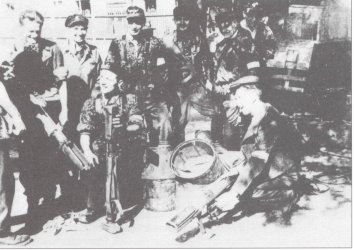
The soldiers of "Radosław" with the airdrop PIATs
The fourth plane, Liberator KG-827 under the command of Lieutenant Jan Mioduchowski, was attacked near Sulejów by a German night-time fighter Ju 88 while on its course to Warsaw. Damaged, it turned back, dropping the containers with weapons over the forest complex in the Piotrków region. They were successfully fetched by a 25 AK (Home Army) guerrilla group operating in that area. The damaged plane reached the base and crashed during the landing at the Campo Casale airport; the crew survived.
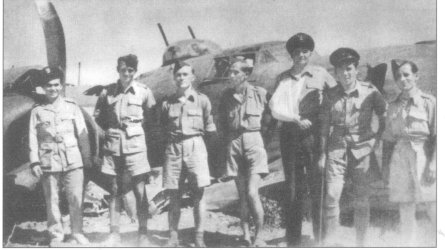
Liberator KG-827 after the return to the base
We might give some thought to how the insubordination of Polish pilots should be regarded. Had it been in times of Austro-Hungarian Empire during Maria Theresa's reign in the 18th c., a state decoration would have been awarded for failing to carry out an order provided that it resulted in evident success, be it in the field of combat or diplomacy. It could well be pinned on the chests of the members of the four insubordinate Polish crews.
The general outcome of the sortie proved tragic for the British crews. After completing the airdrops, three British Halifaxes were shot down near Tarnów and one near Sandomierz by German fighters. In addition, one Halifax crashed during the landing at Campo Casale (luckily, the crew survived). Yet another one got damaged. 17 pilots were killed, 6 were taken prisoner by the German and 5 were seized by the Home Army guerrilla groups.
The scale of losses, coupled with the insubordination of the Polish crews, led to the suspension of all the planned airdrops in Poland. Meanwhile, telegrams were exchanged between the Polish and British governments. On August 6th, Commander-in-Chief - General Kazimierz Sosnkowski - demanded the immediate renewal of airdrops for Warsaw, the help of Polish parachute brigade and the veterans' status for the Home Army soldiers. The response of the British was conservative in its nature, partly because of the hostile stand of Stalin, who dissociated himself from the "Warsaw affair."
On August 8th, the Polish Flight received permission to renew the airdrops in Warsaw. At 19.40, 2 Halifaxes and one Liberator took off at intervals of 5 minutes. The planes carried out airdrops in the region of Czerniaków. They all retutned to base after an over 10-hour-long flight. Twice the Liberator's crew caught a glimpse of the pairs of German night-time fighters. Due to unfavourable weather conditions, the flights to Warsaw were suspended for several days.
On the night of 8th /9th August, 4 Polish crews carried out airdrops over Kampinos near the village of Truskaw.
During the conference of the Mediterranean Allied Air Force (MAAF) in Naples, attended by the Prime Minister Winston Churchill, a decision was made to send the British No.178 RAF Squadron and No. 31 South-African SAAF Squadron to carry out airdrops in the Warsaw zone. Moreover, Churchill cabled Stalin with a request for weapons and ammunition for the fighting Warsaw.
The American, in turn, declared their willingness to carry out a massive day airdrop with the use of flying fortresses B-17, as a part of Operation Frantic. The mission required the Russians' consent for the landing of American bombers at the airport in Poltava. It was a month before the permit was finally granted.
At night of 12th/13th August, 5 Polish and 6 British crews set off. 4 Polish and 3 British crews successfully carried out airdrops in Warsaw. Polish machines dropped the supplies in Plac Krasińskich in spite of poor visibility and ferocious shellfire. The post was marked with cross-shaped lights in the triangle of bonfires. The British dropped the containers in Plac Napoleona. The three of British crews failed to find the targets and returned to the base with the supplies. All of the machines were severely damaged during the shellfire.
Captain (F/L) Roman Chmiel, the navigator of Halifax JP-230 "N," under the command of F/L Edmund Ladro, recalls:
[...] We set off in a group of 7 planes, the weather unsettled. From the Yugoslavian shore we entered the fog that, while not too thick, reached a height of 6,000 ft (1,800 m). Consequently, I used astronavigation - the position of stars - to keep Captain Edmund Ladro, the pilot, on course. We got caught in shellfire over the Danube in Yugoslavia, and then again near Bochnia in Poland. Once we'd left the Carpathian Mountains behind, the weather improved considerably, which was an asset both to us and the German fighters. We saw them attack one of our machines and set it ablaze in mid-air. Since we were much lower, they failed to spot us and we were lucky enough to get to Pilica, easily identified on the map. From there we could see distinctly the glow over the burning Warsaw.
Having passed Pilica, we descended to 700 ft (210 m). From Piaseczno onwards we took the course towards Wilanów and found ourselves above the Vistula river near Służewiec, where German artillery took a great interest in us. We saw flames in many different parts of Warsaw. A terrible sight - truly terrible.
We flew very low, lit by the searchlights which could not keep us in view all the time since now and then we dived into the shadows cast by the higher-situated parts of the city. We could see the trails of missiles closing below the plane. When over the Vistula, we got down below the level of bridges; each time we encountered one, the pilot pulled the machine over and then came down again.
We were to drop the containers with weapons and ammunition over Plac Krasińskich. Somehow I managed to discern the streets through the billows of smoke. We turned left at the Kierbedź Bridge and the pilot hurried to get the plane higher so as to make the airdrop easier (the containers are fitted with parachutes which can unfurl only when dispatched from a certain height). We reached the right altitude just as we were over Plac Krasinskich, in the middle of which we noticed a cross-shaped light signal. Wind dispersed the smoke that kept obstructing the view and I determined that the containers met their target.
Soon afterwards the pilot came down as much as possible because the German centred all their guns on our plane, clearly visible now in the glow of searchlights. The plane's basket was filled with smoke and hot from the flames below us. We steered away from the target along the railway track to Pruszków and Skierniewice. We got caught in artillery fire from an armoured-train when flying over Fort Bema, in response to which we, too, opened fire.
On the way back, in the Podkarpacie region, I noticed the burnt wreckage of the plane that we had seen attacked by German fighters earlier.
The next day the Home Army radio station announced that our entire supply dropped in Plac Krasińskich had been picked up.
As a result of Churchill's intervention, the help for insurgents in Warsaw was increased. MAAF appointed 20 Liberators from the RAF No. 205 Bomb Group to carry out airdrops in that region.
On the night of 13th/14th August, 20 Liberators and 4 Halifaxes from the RAF Squadrons No. 148 and 178 and No. 31 Squadron SAAF, as well as 2 Liberators and 2 Halifaxes from the Polish No.1586 Flight, set off for Poland. During the clearance, the crews were handed in Warsaw city maps in the scale of 1:25,000 and set two fundamental targets: Krasińskich Square and Napoleona Square. The pilots received orders to carry out airdrops at whatever cost, the loss of machines included. The planes delivered the supplies to the appointed locations. 3 Liberators never made it back: a Canadian EV-961 crashed in Park Pederewskiego in the Praga district after the airdrop, with only one crew member surviving. Battered and burning, the SAAF EW-105 made an emergency "belly landing" in Okęcie ; the crew was captured by the enemy. A damaged South-African EW-138 landed at a desolate airport near Kijów. The crew was interned by the Russian and released after a while.
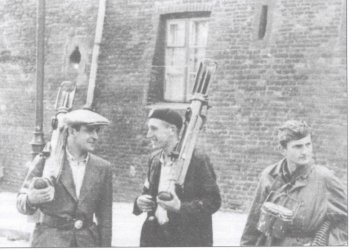
Insurgents with the airdrop PIATs
On the night of 14th/15th August, 26 aircraft set off for Warsaw: 8 Liberators and 6 Halifaxes from the RAF Squadrons No. 148 and 178, 7 Liberators from No. 31 Squadron SAAF as well as 2 Liberators and 3 Halifaxes from the Polish No.1586 Flight.
12 machines carried out airdrops over the capital city in Krasińskich Square, Napoleona Square and the right shore of the Vistula, just behind the Kierbedź Bridge. 8 planes failed to deliver the airdrops due to various reasons (mainly technical).
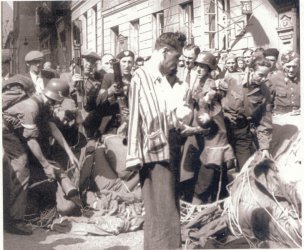
Examination of the airdrop weapons on Tamka Street, Warsaw
F/O Antoni Zagórski, the navigator of Halifax JD-171 "B," under the command of F/S Kazimierz Jankowski, recalls:
Aircraft: Halifax type 2; "B" - Baker-171. Decrepit old wreck, achieved notoriety in the squadron after one of its wing flaps "fell out" (lowered itself automatically).
Base: Campo Cassale, Brindisi
Target: WARSAW
19.38 - We are in the air.
19.44 - 1,000 ft (300 m) above the base, curse 024?, gaining height.
20.30 - We cross the Yugoslavian border north to Orchidske Pleso, the same course as far as the island on the Danube, south to Belgrade. We are safe above the sea and the mountains of Yugoslavia; the predicted storm awaits somewhere behind the Danube. As could be expected, the flap "falls out" when we are above the first mountain range... We lean to the right and lose height. Done, now we know what it looks like in reality...
21.54 - The Danube below us. Course: 000?. I intend to get round Nowy Sącz from the east. It's where night-time bombers operate. Storm clouds build up. We fly at an altitude of 9,000 ft (2,700 m); enough to fly safely over the Carpathian Mountains. We cannot go an further on our Halifax because of the need to save fuel.
22.25 - Storm and lightning, temperature is dropping, a nice chance of icing, the first frost. Luckily, that's all for today, and we find solace in the fact that the night fighters don't like such conditions, either.
23.05 - Height 9,400 ft (2,820 m), a considerable drop of temperature, we enter the atmospheric "cold front." Time to think about descending. We can't see the ground nor hear anything on the radio, no positions to be had, no other navigation aids, nothing. Stars are few and far between. If we start descending too early, we run the risk of flying straight into mountains; if we do it too late, we might get a round from the Nowy Sącz fighters. I spot the North Star, it can't be anything else!
23.28 - Polaris position: 49?32'. That's it! It's almost Nowy Sącz! No time to work out alterations. The navigator addresses the crew: 'We're losing height, everyone watch the ground, tail gunner - watch out for the fighters!' Clouds are getting sparser and ground comes into view; we make sure to go down parallel to the slope of the land. Suddenly, the clouds disappear. Before us we can see myriads of lights and the depths of heights and night. I feel as if we were much higher than we really are. But it's not a good time to reflect on your impressions. We are surrounded by fighter flares on our sides and floodlights in front of us, both gunners shout: 'A fighter to our right!' - and a moment later a calm voice of Janek Gieraga, the tail gunner, can be heard: 'I can see it, Kaziu.' He's in charge now. The flares look like floodlights coming straight at us! No! It's us flying towards them, to the spot where moments ago we saw the bomber. Finally, he's close! 'Kaziu, turn right and dive below him.' We come down fast. Golden sausages flew off on our right side. That's another of those fighters. We dodge... and down we go, the Vistula below us. It's obvious now that down there a battle is being fought, covering the vast terrains from Tarnów to Sandomierz, maybe farther. We flew over the most prominent land bulge towards west... Gone are the lights and flares, floodlights and shells... All I can see in front of me are some reddish lights on the ground, something like beacons... But why are there so many of them? Then I get it: they are the glowing chimneys of burnt villages. It's now obvious to us how far the wave of the Nazi offensive reached before it started to draw back. We are at an altitude of 50-100 m. I look out for the glow above Warsaw. The night is bright if moonless, still I fail to spot anything.... After a few minutes, a tall column of light comes into view; I can count quite a few of those... Explosions! Then it strikes me. They are planes that had been shot down. The war unfolding on the land pushed us slightly to west. The location from which we are to set off for the target is a cluster of clay pit ponds near Jeziorne, then taking the course 340?, upwind, I intend to fly right to the post in Plac Napoleona. I decide that Ogród Krasińskich will prove difficult to reach. I change the course to right, towards the Vistula river... Suddenly, a swarm of shells is dashing towards us from both directions. For a while we get below their bright tracks, closer to the ground. No! All this is not in honour of our arrival, after all, because we can see now oranges coming from one side and green flames from the other. It's a duel between artillery troops! A short moment of pitch dark follows, and again we see the glows of fires... Nałęczów? That's where my mother and sister are! It doesn't look like Nałęczów... Puławy, Dęblin? Some villages nearby? Then we fly over the Vistula and I can see the tip of the left wing as though it was touching the river bank... Not much of a bank it seems! Another moment goes by and I notice Jeziorne and those clay pit ponds (water). Course 340?. 'Kaziu, altitude four hundred, we head for the target!' More and more buildings below us, smokes rise up. We fly into a thick cloud of smoke, penetrated by barely visible flickers of shells. The smoke adds up with the wind direction we had been given, so apparently we are on course - that's my reasoning, at least. The navigator addresses the crew: 'Bomb door open! Get ready for airdrop!' The pilot confirms: 'Bomb door open....' We should be seeing the edifice of Prudential in Plac Napoleona by now. It takes only 4 or 5 minutes to get there from Jeziorne... Zero visibility, I can't even make out the tracers... Maybe the target wasn't as easy as we liked to believe? I decide that we should get round Warsaw from the west side. Course 270?. Darkness envelopes us, but at least we leave the smoke behind. Course 000?. We get down close to the ground. Mundek Szajner informs us in a calm voice: 'The tank is leaking, we've lost quite a bit of fuel, I'll switch all engines over to that leaking tank.' We are at a height of 50 m. Someone asks if we can make it to the base... Then, a panorama of the burning Warsaw unfolds in the east. We recognize the glowing carcass of the Central Starion, and some distance behind it - the lofty Prudential against the background of flames. I think of my friends and kin there, in those fires. There's Lula, fighting along the others... Aunt Marynia in Żoliborz... The searchlights cross above us... We're hoping against hope they won't get low enough to catch us...no such luck. A hail of shells comes right before the nose of our wreck. The plane seems lost. The thought crossed my mind that we would hit the ground in a second. It feels as though hail was falling against the back of the plane's fuselage... Just an impression! It's Janek Gieraga firing his four machine guns. Again, it gets dark and silent. Course 090?. I see the streets, but no fire. Course 160?. More streets and buildings below us, not to mention the ocean of fire. How are we supposed to discern the signal lights among those flames? The horizon is shrinking, the glow of fire obstructing everything that's further away. My guess is that Ogród Krasińskich must be nearby... One more time the searchlights catch us, blinding us completely. I can hear the pilot say: 'Cover me.' The plane begins its dance. A few more seconds, and once again we find ourselves in pitch darkness. At last I understand. Darkness below us is much darker. It's the forest on the east bank of the Vistula river. We are pretty high now, somewhere over Chroszczówka, the plane is on a flat turn left, Legionowo emerges before us... Wanda and Tadzik are there. I can see the river's bright bend, the lights...
'Kaziu, take a left turn.' I spot an outpost, and another one, and another... It's peaceful here, our people control the place.
01.45 am - the containers went down. I see the packages find their targets and some people turning their faces upwards, to us.
01.47 am - Course 190?, back to the base! If only we manage to get to the Yugoslavian frontier, we'll have good chances of making it back to our unit in Brindisi. Everything is quiet; no shooting, no lights. No disturbances in the air. We glide along the sky as though it was the surface of a lake. "B" for "Baker" is doing a great job. We pass Nowy Sącz and the Tatra Mountains, with their highest peaks visible to our right. We go over the sea of middle clouds, the strips of high clouds reveal to us where we can expect a bigger valley or a river... That's right, it all corresponds with a map nicely. Stars are fading, it will be dawn soon. We go over the mountains and Mundek Szajner, our plane engineer, becomes a very important persona now. He seats the gunners in such a way as to make them watch the numerous signal lights of a fuel tank. 'Watch out for the red lights, they mean that there's no more fuel, so you need to report that immediately,' he instructs the gunners. He comforts the pilot that, should one of the engines fail, he'll switch the container right away. And so, one after another we drain the containers like the bottles of scotch. The sun is up. We can lose height now. There's some 'grand capital' below us. Cetynia, or perhaps Tirana? We glide over it in bright sunlight. I change our course to more or less 245? and ask the radio operator for QTE or QDM. What do you know? They respond instantly: 256?. I wasn't much mistaken, and they must have believed us dead.
06.38 am - we land - after eleven hours and ten minutes of the flight on that lousy Halifax 2, and with just a few droplets of fuel left. In a canteen, the plane engineer tells me, a charming smile never leaving his face, that other than some minor holes we also had our glycol chilling tank punctured, luckily in its right upper corner so some of the stuff stayed in. During the clearance, we found out that "eight aircraft were shot down that night, including two from our Flight, as well as that we and another crew were the only ones to complete the task successfully.
The losses were extensive. Operational losses amounted to 31%, of which London and General Bór-Komorowski were duly informed. 4 planes were shot down in Warsaw: Halifax JN-926 of No. 148 Squadron RAF was shot down and landed on Redutowa Street (Wola), part of the crew perished; Liberator EW-264 of No. 178 Squadron RAF hit the ground all on fire in the region of Bateryjka (Ochota), no members of the crew survived; Liberator KG-836 of No. 31 Squadron SAAF crashed near Miodowa Street (The Old Town), no members of the crew survived; Liberator KG-871 of No. 31 Squadron SAAF was shot down by the anti-aircraft artillery in Golędzinów (Praga), no one survived.
It was women who had a direct contact with the airdrop planes. For instance, there was always a group of women and young girls waiting in Krasińskich Square, in Krasińskich Garden. At dusk, they would lie down on the ground in a form of the agreed-on geometrical figure - be it a cross or a star - and waited, torches on their chests, for the arrival of the planes.
That airdrop resulted in yet another tragedy. As already mentioned, one of the planes, all ablaze, was flying over Miodowa Street towards Krasińskich Square. Possibly, the pilot wanted to land; however, 100 m before the square its wings caught on the roofs of the buildings lining both sides of the street. Fuel tanks placed in the wings set those buildings on fire. The plane hit the ground; should it have carried on for another 100 m, it might well have crashed down on the women signalling the airdrop location.
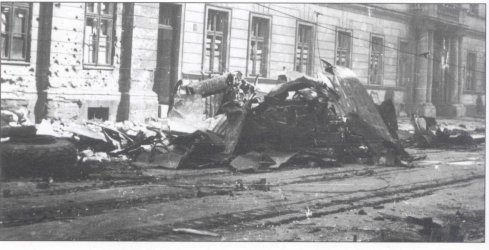
Wreckage of the SAAF Liberator on Miodowa Street
At No.15 of Długa Street, the airdrop supplies were stored and carefully distributed. Obviously, those who happened to be near had greater chances of getting them. The equipment then found its way to the troops. All this was supervised by women.
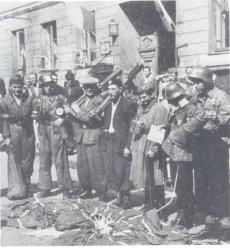
The distribution of airdrop weapons
Four more planes were lost on their way back to the base: Liberator KG-890 of the Polish No. 1586 Flight was shot down near Bochnia by German fighters, no crew members survived; Liberator KG-873 of No.178 Squadron RAF was shot down near Tarnów , the crew perished; Liberator KG-828 of No.178 Squadron RAF was shot down near Tarnów , the crew perished; Liberator KG-939 of No. 31 Squadron SAAF was shot down over Warsaw by anti-aircraft artillery and crashed near Michalin, in the Otwock region, 2 members of the crew were killed, the rest reported to a Soviet unit they encountered, were interned and, after some time, transferred back to the British.
Bór Komorowski sent a telegram to the Commander-in-Chief's Staff saying: '[...]The efforts of your air forces enabled us to continue the battle. The fighting Warsaw would like to thank wholeheartedly the heroic pilots. We pay homage to those killed in action...'
An enormous effort of the crews was only partially successful. Sadly, about 30% of the containers landed in the areas occupied by the German. Within a period of two days, 11 machines failed to return to their base; several extensively damaged bombers were scrapped. The British squadrons lost five crews, as did also the SAAF squadron; the Polish Flight lost one crew. It was the most experienced crew of Captain Zbigniew Szostak with several successful flights to Warsaw on their record.
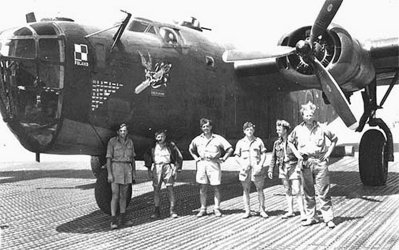
The crew of Liberator under the command of F/L Szostak
Owing to the extent of damages, Marshal Slessor once again suspended the airdrops in Warsaw. However, he gave a permission to carry out flights to Kampinos, the Chojnowski Forest and other woody areas near Warsaw.
On the night of 15th/16th August, 3 Polish and 6 British crews set off for that area; 5 of them carried out the task, delivering the supplies in the vicinity of Kampinos Forest; 4 other returned to the base with their cargo.
On the night of 16th /17th August, 18 planes set off: 5 Polish bombers as well as 13 RAF and SAAF planes. 15 planes succeeded in carrying out airdrops in Kampinos area. The raid sustained severe losses; 2 Polish crews, 3 SAAF crews and 1 RAF crew never returned to the base. Halifax JP-220 from No. 1586 Flight of the PAF was shot down by a night fighter near Bochnia; a radiotelegraph operator was killed, a pilot made an emergency landing and, wounded, he was taken prisoner, while the rest of the crew jumped with parachutes and was intercepted by the Home Army troops.
The commander of Halifax JP-220 "C", Warrant Officer Leszek Owsiany, recalls:
'The targets of tonight's operation are Warsaw and Puszcza Kaminoska' - these were the words in which the intelligence officer started the clearance. A map of Europe is hung on the wall, with a red circle in its very centre designating Warsaw. Next to it there is a map of Warsaw, marked with the locations that are now in insurgents' hands. 'You may choose any route you wish as long as you stay clear of the new locations of anti-aircraft artillery and the locations of German night-time bombers' flights; all that has been marked on the operational map in accordance with the latest findings of our intelligence service. It will be up to you when you want to set off, but you have to reach the target some time between midnight and 2 am so that you can avoid the German fighters on your way back across Hungary and Yugoslavia. Remember that the sun rises at 4.20," the officer concluded. When the eastern front was moved to Poland, the German bombers' flights were located in Hungary, Czechoslovakia, Romania and Poland. There were more and more of them on the operational map. My crew was joined by, Sergeant Kretowicz, a co-pilot; Lieutenant Łopuszański, a co-navigator; and Lieutenant Bernhardt. A freshly formed crew, the boys came from England, and the flight was supposed to introduce them to the operation's paradigms.
It's 2 pm, the sun is beating down relentlessly. Scattered around the airfield, good old Halifaxes seem to be wavering in hot air. Our "E" for Ewa perched itself on its shock absorbers, loaded to the full. A makeshift shower installed on the flat roof of our quarters washes off the sweat, giving us a momentary relief.
18.30. Just as we are about to set the engines in motion, the commander drives up and, offering us cigarettes, he says:
'The fact is the entire crew had their turn already, but because of the current situation in Warsaw and the lack of other crews you were designated to fly today again. It's your last flight. In three days you're sailing from Naples to England.'
'Stop joshing us, Major, don't make it our last flight,' Stefek Bohanes bristles with indignation, 'operational maybe, but surely not the last one.' We all burst out laughing. 'Since when have you been so superstitious?' the commander asks.
19.00 - take-off. With a horsepower of eight thousand, the plane is roaring up. Powerful Herculeses are rumbling, wings are sending clouds of sand from the metal runway into the air. Slowly, the machine raises the tail and picks up speed. Overloaded, the plane takes off just as it approaches the end of the runway. The wings do not have sufficient support in the warm air and we gain speed very slowly. Temperature inside begins to fall down, allowing us to get a breath of fresh air. I hand over the rudder to the co-pilot and put on my battle-dress. So do the rest of the crew. Once we have reached an altitude of 900 ft, we take a 030? course and bid farewell to a friendly Italian shore. At 8 pm the Adriatic ends and we cross the Albanian border. The sun is setting down slowly. The sky is cloudless. We fly over some mountainous regions. We know that it's still safe there as the airports of the enemy are located further to the north. Captain Schöffer, a navigator and an old trouper, gives us the course alteration.
'Watch out,' the tail gunner says, 'unspecified plane behind u to the left.' It soon turned out that it was one of the two Liberators making up our flight. Jan Lück, our tail gunner, had a great combat experience, was a first-rate shot and a real pro when it came to tactic battle against bombers. The flight goes along nicely, the engines work well both in gear and the boost. It grows dark. Stefek goes over to an "astro" turret and reports to the base that he is keeping a watch. Suddenly, a ferocious anti-aircraft fire from the left breaks the monotony of the flight. Flares and markers show up. It proves to be the bomb raid on Budapest mentioned by our intelligence man during the clearance. Down below us, fires turn the sky pink until it's a glow of flame. The crew remains calm. Aside from the new members, for whom this combat flight is their first one and who consider it a novelty that provokes a conversation.
'You call that a fire? Fire is what you're going to see over Warsaw. Now you'd better hush up and watch out for the fighters.
'Hallo Leszek? It's Władek. Take a course 330. The Tatra Mountains will be there in an hour. Everything's okay.'
Over Czechoslovakia we get caught in the shafts of four searchlights. Jaś fires at them from our four Brownings. The lights go out. Before us we can see Giewont. Each time the sight fills us with joy since it means that in a moment we will be over Poland, our beloved country. Going over the Tatra Mountains Stefek says:
'Boys, we're home, we're in Poland. Can you see Tarnów on the right? My home is there, my mother and family,' and then, after a moment, 'God alone knows when I'll see you again.'
I can hear Władek saying:
'Course 015°, you may come down.'
Once we've crossed the Vistula river and determined our position, we can start enjoying our flight. I raise the armchair, open the window of the cabin slightly so that I have a better view, and breathe in deeply the Polish air. The spirits of the crew are running high, I can feel it. We have only one goal now - to get to Warsaw and drop the supplies as precisely as possible.
The anti-aircraft defence is bound to have strengthened. Fire is what makes the target search difficult. We see a German red beacon on the course. It must be the airport in Kielce. Here, on 1 September 1939, I made my first flight on RDW-8 all by myself. Far to the right fires we see fires, it's where the front is with its heavy front artillery. In front of us the sky seems to be brightening up. As we draw near, we can understand the reason behind it. It's the glow of the burning Warsaw. The co-pilot nudges me pointing to the glow and asks:
'Do you think it could be from Warsaw?'
I nod; his hand clenches into a fist and in the headphones I can hear a litany of grievances directed at Hitler and his bunch. Władek speaks up:
'We're close to Wilanów, I'll tell you when and you know what to do.'
The plan is to carry out the airdrop over Plac Napoleona. To avoid anti-aircraft defence around Warsaw we decided to fly from Wilanów to Most Poniatowskiego following the Vistula river, and then - over the roofs - to our target. We turn right, then left; the plane's fuselage nearly touches the water surface and we approach the bridge following the middle course of the river. The smell of burning city pervades the cockpit. All of a sudden, the searchlights lining the bank to our right, from the direction of Praga district, catch us with their bright pincers. We are caught unawares - could it be the German out there? A series of shots from the turret puts them out in a moment. We can now see the piers of the bridge drawing near; we go up and turn to fly over the roofs. Clouds of smoke and the glow of fires makes the horizontal visibility extremely hard. I call out to the navigator:
'The bomb door's open - I'm slowing down.'
I hear:
'Left, left, that's okay...' and that is when I see the "Prudential" right in front of us. I lean the plane slightly on the wing to bypass the skyscraper. The plane bobs up unexpectedly: the packages have been dropped. The plane seems to have rejuvenated at once. We all feel happier now that the task is done. We speed up. The citadel opens the fire, with little pearls dropping down from the roof just in front of us. It's a German MG. Our front gunner gives as good as he gets, firing short bursts at them. The smokes thin out; we leave the city behind. We fly slightly to the left and, after a while, I recognize a clay pit pond in Włochy. We cross the railway station in Włochy and reach Aleja Żwirki i Wigury, going right into the wall of fire coming from some light anti-aircraft weapons (later on I found out that German anti-aircraft troops were located there). Low altitude and speed are what saves us. The further we are from Warsaw, the more relaxed we feel.
Deep in thoughts after what we've experienced, we refrain from breaking the silence. I hear some cursing through the headphones and recognize it to be coming from Jaś, our tail gunner:
'Władek, are you sure the airdrop hit its target?'
'I'm 200 % sure.'
'Good.'
Luckily we did it in one go.
'They sure are blasting it!' says Stefek. 'I guess they got themselves some Englishman; he's flying too high because that's what the "King's Regulation" recommends and they stick to it.'
'And you should use common sense, that's what' provides Grześ, our plane mechanic.
'Listen, Grześ, are the containers full?'
He replies that the clocks point to everything being ok. The co-pilot hands over a lit cigarette and we smoke it with pleasure. Władek gives us a course alteration and announces that in five minutes we are going to be in Brindisi. Fatigue and stress are taking their toll; ten hours in the air, night in night out. The flight is pleasant, visibility is good and I think how nice it would be if it stayed like this all the way back to the base. Still, the memory of confrontation with fighters near Nowy Sącz two days earlier is very much alive. It was cloudy then, and Jaś did a very good job again. The peaceful flights from the times when the front was in Ukraine and the air was free of the German were now a thing of the past. Someone nudges me and passes a vacuum flask. Oh, what a wonderful wine with lemonade and some ice cubes.
'I wonder if our package landed undamaged,' says Stefek in a concerned voice.
Each crew added their own package with some oranges, almonds and figs to the rest of the supplies, with a tag saying that it's from the crew.
We have left the Vistula behind and the visibility begins to deteriorate. After a short discussion I decide to go higher. At 3,000 ft we can see absolutely nothing. We gain height in order to get a safe passage over the Tatra Mountains. Władek informs us that in fifteen minutes we're going to cross the border. The engines work steadily, the silence hangs in the air. Suddenly, I feel some turbulence, the plane jerks to the front, I see a flash on the cockpit's windscreen. We go into a nose-dive. I take hold of the yoke and it jerks onwards immediately. The plane speeds up. With the aid of the co-pilot I succeed in bringing the plane gently down but we still can't set it horizontally. The headphones are dead - it strikes me that our phone has been damaged. We've lost over 1,000 feet so the ground must be close. I assess the situation and determine that there is only one way out. I call out to my co-pilot:
'Jump!'
The stream of air comes into the cockpit, sending the floor dust up right into our eyes. The hatch is open; I can see one human form after another disappear through it. I try to keep the plane as stable as possible in order to give the crew maximum safety during the jump. It's my turn now. Where is my parachute though? I realize that the plane mechanic failed to hand me the parachute, this being his duty. I look down the hatch and, seeing it raise, I call out:
- My parachute!
At that very moment some hands pass it to me. The situation is grave; with the yoke tightened on my chest, I cannot hook the parachute on the snap-links. Should I give in the yoke, the plane will nose-dive, making it impossible to get from the cockpit to the hatch. I call out to Jaś: 'Jump!' He shakes his head. There is only one thing left to do - an emergency landing.
I accelerate and the propellers pitch slightly. The engines roar loudly, making the plane's front come up a bit, although not enough to set it horizontally. I take a 180? turn and we speed as far as possible, hoping for some flatter ground. How long we were hanging like that - I cannot tell. It seemed like ages. The land is closer now and visibility improves. Janek takes the mechanic's position. I see the trees swiftly drifting by. I get rid of the cockpit's roof in case we should take off. Some three hundred metres away the floodlit buildings of some kind come into view. We have passed by a tree below the level of its top. I realize that we are not going to pass this building. The flight is over.
The last thing I remember is slapping my hand against the magneto switches. I felt terribly cold and shivery. I heard someone say:
'You're pretty battered, Lech.'
When I came round, I was lying on a sofa, an unfurled parachute beneath me. A woman's crying reached my ears:
'The German will shoot us all.' The door opens, in comes Jaś with two young men.
'We can't move him in this condition; it's thirty kilometres through the mountains. It can't be helped, he has to stay here, it's for his own good.' I realize what that means - captivity. I notice now that Janek is none the worse for wear other than having a handkerchief wrapped around his wrist. A heartfelt handshake of undamaged left hands - take care, Lech - I'll see you later.
He turned from the door, unbuckled my belt with a revolver and put it between my legs - you might need it. Soon afterwards a roar of a car drifted into my consciousness, silence, and then a sound of heavy footsteps in the corridor. The German. Captivity.
A man sturdy like an oak is standing framed by the door, "Schmeisser" pinned to his chest. Nodding, he says:
'Ja, ja mein Lieber.'
Then he noticed the Parachutist Badge on my uniform. Coming up to me, he tore it off abruptly and put it in his pocket. He muttered through the clenched teeth:
'Polonische Schwein.'
I felt a terrible pain in my right side and heard some words which seemed to be coming from behind the wall:
'Congratulations,' he said in perfect Polish. 'The war's over for you, you're safe now. Now we have to fill in the Red Cross forms. You have family in Poland, friends in England; surely you want to let them know the good news. So - what are your name, military rank and number? And now... your unit number, location, the name of your commanding officer...
Liberator EW-275 of No.1586 PAF Flight was shot down by a night-time fighter near Tarnów, 5 pilots died parachuting from a low height, 2 more were killed on an exploding plane; Liberator KG-933 of No. 178 Squadron of the RAF crashed in Zabłocie, in the suburbs of Kraków, with 3 crew members killed in the process; Liberator EW-248 of No. 31 Squadron of the SAAF was shot down by a night-time fighter near Kraków and exploded in mid-air, only a co-pilot managed to jump out and was intercepted by the Home Army, the remaining seven crew members were killed; Liberator EW-161 of No. 31 Squadron of the SAAF was attacked by two fighters near Tarnów, the whole crew perished; Liberator EV-941 of No. 31 Squadron of the SAAF was shot down in the Kraków area, the whole crew was killed.
Following the extent of the damages, No. 178 Squadron of the RAF and No. 31 Squadron of the SAAF were withdrawn from the flights to Poland. The Polish No. 1586 Flight and No. 148 Squadron RAF waited for the supplementation of the planes.
On the night of 17th /18th August, four Polish crew set off for the Puszcza Kampinoska region, one of which carried out the task successfully, dropping the supplies over Kabacki Forest.
On August 18th, Friday, General Bór-Komorowski sent a telegram: '... Śródmieście and Kampinos districts are on the alert today. The district of Kabaty burnt down. Enemy concentration...'
Major Jadźwiński, the Base Commander, sent three Polish Halifaxes to Puszcza Kampinoska without alerting the English. Due to a very poor visibility, only one Polish crew carried out part of the task. The other planes returned to the base with the load. Each passing day helping Warsaw proved harder.
On August 20th, No. 148 Squadron RAF was withdrawn from the airdrop flights. Only the Polish No. 1586 Flight had a consent to carry on.
In the period from 20th to 28th August 1944 thirty eight flights were carried out to Warsaw and Puszcza Kampinoska by the aircraft of the Polish No. 1586 Flight PAF, 3 of which ended in airdrops delivered over Warsaw (2 on Ulica Marszałkowska and 1 in Mokotów district), 18 airdrops were carried out in Kampinos area or in the vicinity of Warsaw. During the time 4 Polish planes of No. 1586 Flight PAF were lost.
Pilot Officer Zygmunt Nowicki, the radiotelegraph operator of Liberator KG-927 "S" under the command of Captain Jan Mioduchowski, recalls:
The day of August 27th was, as usual during this season in the south of Italy, hot and sultry. We found out in the morning that we were to go at night. No one told us where to, but the whole crew had a feeling it was to Warsaw. We weren't mistaken. The clearance; general information and details, trivial remarks and advices we had heard hundreds of times before... Just before the take-off, the crew - Captain Jan Mioduchowski a.k.a "Jasiowa," Warrant Officer Henryk Jastrzębski, Lieutenant Navigator Stanisław Kleybor, a radiotelegraph operator Lieutenant Zygmunt Nowicki, our mechanic Warrant Officer Emil Szczerba, a gunner Captain Józef Bednarski and a gunner Warrant Officer Tadeusz Ruman - gathered by the wing of Liberator "S - for Sugar" and the navigator expressed the thought that was gnawing at us all:
'We must reach the target at any cost and deliver the airdrop supplies to our people in Warsaw!'
No one bothered to comment on that since we all understood each other without words.
We took off at 19.15, with the sun still over the horizon. One round over the airfield and off on the course to the north, over the Adriatic, on a height of 3,300 m. The mountains of Yugoslavia, the Danube, lights and searchlights - the same old story. We reach the line of the Carpathian Mountains. That's our landmark; from this point on we get down - it's better to fly sideways when in Poland. The enormous engines of our Liberator work faultlessly, all members of the crew carry out their tasks in a calm and methodical fashion.
We still have some 40 kilometres to Warsaw, but for some time now we have seen a blood-red glow on the horizon which, as we approach the burning city, grows more intense. And here we are on the outskirts of Warsaw. At a height of 300 m, we see an ocean of fire and smoke beneath us. It is possible to distinguish particular low-rise buildings with the floors on the ground floors burning out - everything higher than that is already scorched. In a fraction of a second the tragedy of people down there strikes you; of those who fight and those who have been captured in this hell without a possibility of ever breaking out. It's a heartbreaking and nerve-wrecking experience. At times you forget even about your own safety. Blinded by the vast stains of fire, eyes can barely discern the cross-shaped lights marking an airdrop location. Still, we find it and come nearer. The bomb door is open. Down go the supplies. The German lie low, neither shooting nor pestering us with their searchlights. This, however, is just the calm before the storm. Suddenly, we are caught in the shafts of light coming from a dozen or so searchlights, and the anti-aircraft artillery starts shelling us with quick-firing cannons and machine guns. Shells of different colours - orange, red, green and white - are dancing around the plane as though it was Midsummer Eve, every now and then hitting the target. It feels as though some huge steel battleaxes were banging at our plane, making Duralumin and steel moan under their heavy blows. 'Lower, lower!' calls the navigator, even though we are already very low. However, that's the only chance we have.
We get lower, nearly crashing into the church spire in the process, and head for the west. We know we have been shot, but at the moment it is difficult to assess the extent of damage. One engine - the right internal one - has stopped. Immobile blades protrude helplessly; a truly pitiful picture. After a few minutes, the left internal engine grinds to a standstill, too. The pilots exchange some remarks, after which we hear over the intercom that it's bad. With only two engines left, we have to be prepared for the worst. The pilot suggests that we put on the parachutes lest we must jump over Puszcza Kampinoska. Meanwhile, the wounded plane keeps going and -what do you know! - it slowly gains height. We are at 700 m above sea level. We hear the mechanic announce that the dispatcher is wounded. The least busy member of the crew (a radio operator - gunner), I leave the middle turret and squeeze my way to the back to help the injured man.
His wound turns out not very serious - shrapnel in his forearm - so I dress it swiftly and return to my post. I turn on the radio only to find that, to my relief, both the radio and the receiver are still working. I encode one telegram, then another, and send them to the base. There is no reply, though. We learn later on that the aerial was shot off and the transmission range of the receiver was very limited as a result.
Meanwhile, our brave Liberator has reached a height of 1,300 m and we are on course to the pass. Two engines still working, we decide that if we manage to reach 2,000 m, there's no need to jump. The navigator works out all possible courses for the route at this altitude. When we are near the Carpathian Mountains, a single anti-aircraft cannon fires at us, and effectively at that, with three shells meeting their target. One goes through the fuselage, inches above my head. Luckily, I am sitting by the radio station; were I to be standing at that moment, I would have been shot for sure.
When the pilots announce that we are at 2,100 m above sea level and have a good chance stay there, we all feel that there is still hope of getting back to the base. Everyone prays silently for a happy return.
After long hours of uncertainty, we finally arrive at the base. Checking the radio installation earlier, I found out that the radio station was not working. Therefore, I retuned the equipment and taught the pilot how to reach the air-traffic control tower.
We land at last. All those gathered in the front part of the plane await apprehensively the final act of this drama. We reject the upper door just in case, lest it should jam in the crash, since this exit is necessary to leave the plane quickly. The plane's wheels touch the runway. We can feel them rolling along the surface.
However, we notice that the plane fails to slow down. We have taxied half the length of the runway and the blue sea, its tidewater laced with white froth, grows dangerously close. Suddenly, the plane turns abruptly, hopping over the furrows in a vineyard and some low pebbled walls. Then a huge bounce, a bang, a turn backwards - and, at last, a deafening silence. In a matter of seconds we help each other get off the plane as one of the still working engines sparks off.
It's 05.20. The sun is up. The fresh air of the morning, the greenery, the whisper of the sea and the quiet are like balm to our souls.
The plane is in pieces, twisted and furrowed with bullets. Airfoils have half-meter wide holes in them. It's no more than a heap of junk. Still, we feel deeply grateful to it for its courageous effort to win against the odds, even if the victory meant its ultimate destruction. Thus passed the brave Liberator "S-for Sugar" with its red-and-white chequered pattern, the Liberator fighting for Liberty. Even before our arrival at the base, Warsaw sends confirmation of the airdrop having been received, and within 24 hours the President of the Republic of Poland sends via telegraph the Orders of Military Virtue for the entire crew.
Halifax JD-362 was shot down over Hungary, the entire crew was killed; Halifax JN-895 was also shot down over Hungary, again the entire crew was killed; Halifax JD-171 was shot down near Mohacz upon the Danube, near a border between Hungary and Yugoslavia, only one member of the crew survived and, seriously wounded, was taken prisoner; Halifax JP-295 went missing along with the crew, probably drowned in the Adriatic. Following the extensive losses the British General Headquarters suspended the flights of No.1586 Flight to Warsaw and Kampinos.
In September, the Allied planes delivered about 52 tons of weapons and ammunition in the Warsaw area, of which only 35 tons reached the insurgents. Numerous airdrops were carried out in the area of Puszcza Kampinoska and the Chojnowski forests. Unfortunately, only a small part of them was transported to Warsaw.
During the airdrop flights, the Polish Flight lost 10 planes and 8 crews. The RAF Squadrons lost 11 planes and 10 crews, while the SAAF lost 8 planes and 8 crews.
Sergeant First Class Tadeusz Ruman, the gunner on Halifax JP-251 "P" under the command of W/O Henryk Jastrzębski, provides a following recollection:
My first flight over insurrectionary Warsaw took place on 4th August 1944. It was on a Halifax. We used to fly at night. We would take off at about 7 pm from Brindisi, Italy, go over Yugoslavia and Hungary, and get to Warsaw around midnight. We returned to the base in the morning. The first flight was surprisingly uneventful - I don't suppose the German expected us.
Then, it was worse with every successive flight. When we arrived in Warsaw for the first time, it was an incredible feeling; we knew our friends were down there, picking up the airdrop supplies.
We could see the cross made of oil lamps on the ground, and did our best to drop the packages on this very spot. Each flight was preceded by the clearance, during which we were informed of the airdrop location - of were the cross of lights would be. We flew just above the house roofs because the crosses were no longer than 10 m. We tried to be on time.
They were always there, waiting for us. London got the information about the airdrop being received.
The supplies included weapons and ammunition. I cannot even tell what kind of weapons because it was packed in containers. In other countries we would also drop food and cigarettes, but it was only weapons for insurgents. In Yugoslavia, for example, where there were two leaders - Tito, a communist, which to us was like a red rag to a bull, and Mihailović - we even delivered some bags filled with cigarettes. We would put one such bag aside sometimes and drop it later over Poland, along with the weapons. It was off the record, but still it happened. There was never a shortage of cargo, anyway.
The containers were carried underneath the plane, were bombs usually were.
Our crew was entirely Polish. The English crews were sent, too, but only until Churchill suspended their flights on the grounds that the losses were too extensive. He decided that it was a suicide.
Our first flight might have been uneventful, but after that Warsaw was on fire. There was no need to navigate the plane. We simply flew over the Vistula and from that point the glow over the city was impossible to miss. The intelligence kept providing us distressing news about the Uprising from Bór-Komorowski...
Our special duty flight consisted of six planes. The difficult part was an endlessly changing line-up. With no anti-fighter cover, we sustained heavy losses when over Warsaw, amounting to over 200% of the flight. Even now people ask me: 'Tadek, you were in that special duties flight, did you know so-and-so? He was killed.' And the truth was, a crew arrived, then left after two or three days and... often that was the last we saw of them. There was no time to get to know each other. And I don't even remember some of the colleagues.
My flights to Warsaw took place respectively on 4th, 7th, 13th, 15th, 21st, 24th and 27th August. We stayed up to two minutes over the city proper. 11 or 12 Polish planes were lost in the process.
Only experienced pilots were chosen for special duty missions. On August 15th my friend, Zbigniew Szostak, was killed; he confided in me beforehand that he had a feeling it was to be his last flight.
We didn't think about the losses then, what pried most on our minds was the sight of Warsaw on fire and the thought of our brothers down there, dying. We always listened to the radio once we returned from the flight. It angered us that the Russian, who could come to our assistance at any time, never fired a shot. That, I believe, was the greatest betrayal of the World War II.
Our last flight was the most dramatic. We reached Poland with only two engines working. Four of our planes were lost. That time I flew on a Liberator. The German fired at us furiously in the district of Mokotów. It was dark, and flying too low we didn't even had a chance to jump with parachutes. Therefore, we decided to head southwards in order to gain altitude, and then parachute.
Landing was out of question, but somehow the two engines settled down by then. A small German unit attacked us near Kraków. A series from a machine gun ran over the plane, but we made it over the mountains and wanted to jump in Yugoslavia. Being close to the base, though, we thought we would try to reach Brindisi. The brakes seemed to be working properly, according to indicators. In reality, everything was bullet-ridden and there were no brakes. When we landed, the mechanics found that the fuel supply we had left would carry us for some 5 more minutes at most. The also checked our parachutes; they all turned out to be riddled with holes.
Had we jumped with them, we would have died, since a small hole can tear the canopy. That we managed to return was nothing short of a miracle. Once I got off the plane, I kissed the ground and thanked God for saving my life. Wherever I go, I carry a simple aluminium medallion with an icon of Holy Mary on it. I took part in 71 operational flights from England and Italy, and the medallion was always on me. I wouldn't part with it for millions of pounds.
On 27th August 2003, exactly 59 years after our last flight in aid of insurgents, the one when we really got a licking, the Monument to Fallen Polish Airmen was unveiled in Mokotów.
The suspension of the airdrop flights to Warsaw generated a wave of protest on the part of the Government of the Republic of Poland directed at the British Government. After the suspension was withdrawn once again, on the night of 1st/ 2nd September, 2 Polish Liberators set off from Brindisi to carry out airdrops in the Kampinos region. At the same time 5 Polish Halifaxes were supposed to deliver supplies to the locations in the area of Kielce and Radom. Only one of them returned to the base, having turned back from the course due to an engine defect. 4 other were destroyed on their way back over Hungary and Yugoslavia. Most of the crew members were killed. That contributed to another break in the flights.
Persistent intervention of the Polish authorities resulted in a greater number of the British air force units being sent to Poland from Italian bases.
On the night of 10th/11th September 1944, twenty fighters set off for Warsaw: 5 Polish, 12 British and 3 South-African planes. They were to carry our airdrops over such Warsaw districts as Śródmieście, Mokotów and, if possible, Żoliborz. 12 planes completed the task: 3 in Śródmieście, 2 in Mokotów and 2 in Puszcza Kampinoska.
5 planes, including 2 Polish ones, were shot down. Liberator EW-278 of No. 1586 Flight of the PAF exploded mid-air over Yugoslavia, close to the border with Hungary. Four pilots jumped off the plane and were taken prisoner, the others died. Halifax JP-288 of 1586 Flight of the PAF was shot down near Budapest, the crew died; Halifax JP-161 of No.1586 Flight of the PAF fell down in Yugoslavia owing to the lack of fuel, the crew parachuted, with 4 pilots taken prisoner and 3 other returning to the base with the help of the Yugoslavian guerrilla fighters. Halifax BB-422 of No. 148 Squadron of the RAF was shot down over Hungary on its way to Warsaw; the crew was captured by the enemy. Liberator EW-198 of No. 34 Squadron of the SAAF fell down on its way back owing to the lack of fuel, only 2 pilots managed to parachute, the others died. Several planes that found themselves beyond the front line were fired at by the Soviet artillery. These were the last flights to Warsaw made by the RAF and SAAF crews.
On the night of 13th/ 14th September, 2 Polish Liberators set off for Warsaw. One of them dropped the supplies over the city, the other one - KH-101 - was shot down over Hungary when on its way to Poland. These were the last flights of No. 1586 Flight, which lost 12 crews altogether.
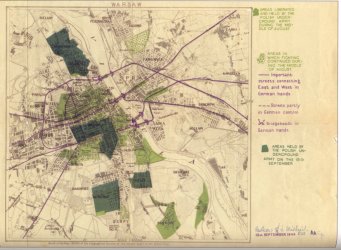
The map of Warsaw handed to the crews carrying out airdrops
Apart from the losses sustained directly in Warsaw, the majority of planes were destroyed in their way back to the base in the area of Tarnów or near the border between Hungary and Yugoslavia. It was because of coordinated actions of the German night fighters who worked out a special strategy of attacking the returning Allied planes, which had already been damaged in anti-aircraft fire, and the crews of which were fatigued after the hours of difficult flight.
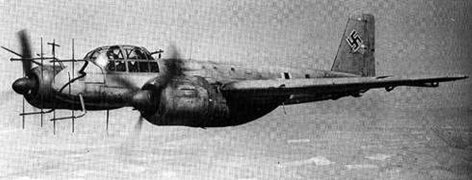
A German night fighter Ju88 (according to Luchtoorlog)
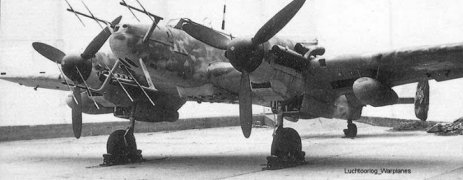
A German night fighter Me-110 (according to World War II planes)
Pilot Officer Włodzimierz Bernhardt, the pilot of squadrons No. 300 and 301, the soldier of the Home Army, recalls:
The flights to Warsaw were of the most nerve-wrecking kind, and the reasons behind it were both technological and emotional. It was so hard to look down at the burning out city and think of what those people were going through.
Prior to that I was flying in the bomber squadron, we bombed Germany and those parts of Europe that were under occupation. Just before the Uprising I was moved to Squadron 301 in Italy. In percentage terms, we suffered the greatest losses during World War II. This was a different kind of a feeling, the hopelessness and pain at seeing everything fall into ruin and being unable to prevent it.
Flight conditions were difficult, and we lacked all the electronic radar devices that we had had in Europe since everything ended over the Adriatic. After that point, you had to rely on a so-called "african navigation" - your finger and wind; well, there was also astronavigation, but no ground technical assistance. Moreover, the flying technique was entirely different. Before we used to carry out air raids in what we called a "high war" way - with a high ceiling; now it was something different, the only chance of success and survival we had was to come down as low as possible.
As soon as we reached the Yugoslavian shore after half-an-hour flight over the Adriatic, we encountered the German. Then we went along the Hungarian valley to Balaton where we couldn't rely on a friendly welcome, with two night bombers' airports situated there.
We kept low all the time. Only when we approached the Polish border, near the Carpathian Mountains, we flew higher so as to go over the Tatra Mountains. We entered Poland from the direction east to Nowy Targ since that was the easiest way.
More or less from Pilica we could see the smoke - the glow. Often we carried scraps of burnt paper in the cabins, which was heart-rending. And then we headed for Warsaw. Obviously we couldn't go over the right bank of the Vistula since there were "friends" who warned us that should we do that, they will fire at us because they cannot tell as apart from the German bombers.
On reaching Warsaw all we could see was all-embracing smoke; here and there we could see pillars of fire, and we had difficulty finding the location. And that's where the real fun started. We got really low, hedgehopping wherever it was possible, and headed in the direction of Plac Krasińskich where the target location was situated. If you spotted the lights, you were supposed to memorize the place because smoke would obliterate it in a matter of seconds, come close and carry out an airdrop. It worked most of the time.
The flights were exhausting - you had to go back and once again the dancing began. You went low, then higher when about to get across the Tatra Mountains. And then there were the German waiting on the other side. Sometimes they would let us get across on our way to Warsaw - though of course they would shoot at us whenever they managed to spot us - but it was on our way back to the base that the real hunting took place.
They formed the so-called "chimneys." By these I mean rows of bombers that flew at different heights and caught us there. We sustained the greatest losses there. There was an anti-aircraft defence in Warsaw, too, but in comparison with the Ruhr Area or Berlin it was not nearly as strong.
On the way back, between Warsaw and Bochnia where we had to get higher, there were two so-called "blinkers" - German radio stations which transmitted one letter. It was a navigational help for the German planes. Later on, it also served as a navigational point for us, letting us know where we were. Some crews got it wrong and approached the Tatra Mountains on too low a height, which meant trouble for them. The trick was to gain height after you passed the second "blinker."
The return to the base was gloomy. It was the image of Warsaw on fire that prayed on our minds the most. It was much worse than being caught by the searchlights over Berlin. All a man was afraid of there was to be caught and shot at, but all in all that was natural - we were soldiers. Here, we were hit by realization that there was nothing we could do to help.
Once we were back, a mechanic would ask what it had been like in Warsaw. And we couldn't bring ourselves to tell the truth; they also had their families there. If it hadn't been for the maintenance crew, we wouldn't have been able to fly at all. I'm at a loss for words to express our feelings for them. They worked tirelessly, and yet no one made them toil so hard. We kept the details from them simply because we didn't want to dishearten them.
The losses were substantial. My squadron lost 17 crews, 7 members each, during the Uprising between August 6th and September 18th, after which day the flights became suspended. The airman is trained differently from a foot soldier. It takes at least a year or more to train a pilot for operational flights. A regular line-up of the squadron amounted to 18 aircraft.
There were some nights that proved simply awful. I can't remember the exact date, it might have been the second half of August or the beginning of September. Seven planes from our squadron were to fly - we went to Warsaw. It must have been the longest flight of my life. On our way back Junkers stuck to us. I had to get rid of the bastard and so I went southwards instead of westwards. We finally managed to lose him somewhere over Kielce and then I returned to the southward route.
We reached the base with only few drops of fuel to spare. We flew over Albania and passed Tirana on the way. It was a beautiful morning. I remember the carts and oxen standing on the market place. The farmers were waving at us. The mechanic kept looking at the watch to control the fuel level. We go over the Adriatic, I call the airport and report that we're coming back. I can hear joy in the flight controller's voice. We go down and get ready to land. Wheels brushing against the runway, the engine stops - the fuel has run out. Some landing! The mechanic keeps telling us: "See - you always panic and we have so much fuel left that I can refill a cigarette lighter with it for each of you." We get off, the airport is empty and silent. I ask the ground maintenance man why it is so quiet there. "That's because you're the first - no one else has come back yet." And no one will. That proves how lucky I was.
The average lifespan of a bomber crew was estimated to be 3 flights; in practice it was 5-7 flights. The round of flights amounted to 33. The losses were greatest at the beginning and the end of the round. No one was forced to fly. If a pilot was emotionally unable to carry on with the flights, he was free to stay behind. I remember my friend, a very good pilot, who after his 28th flight decided that he would never get on a plane again. The talks with psychologists didn't help and he was transferred to a post in administration. No one thought him a coward. He just burnt himself out.
When flying over Warsaw, the pilots would hedgehop - often at a height of 100 m - getting ready for an airdrop, then they opened the flaps and lowered the landing gear in order to slow down the plane as much as possible.
The SAAF pilots were as great as the Polish ones and sustained as severe the losses. They did their very best. The English flew well, too, but the Afro-American airmen did it with a daredevil streak.
The Polish crews would often fly on the machines that were not quite up to scratch - anything to help Warsaw.
On the night of 16th/ 17th August my plane (Halifax JP-220 "C" commanded by Leszek Owsiany) was shot down near Tarnów. Having jumped with a parachute, I landed on a tree and hanging there I tried to figure out how to get down. At last, I managed to swing the belts and reach the trunk. I unfastened the belts and clambered down. I sat down under the tree and tried to light a cigarette, but that proved tricky. My hands refused to cooperate, they would make all the wrong moves. Nerves. Finally, I decided to leave the place; however, I could hear the sound of shooting all around and see the bangers on the horizon. My zeal for leaving abated. Some time later I got out of the forest and on a field track. I noticed a man near the village buildings. He was walking in my direction and once we'd passed each other he looked around and so did I. I came up to him and explained my situation, I had no other choice. The woods I came out of were crawling with the German and the morning was nigh. The meeting proved to be a blessing for me. Soon afterwards, the guerrilla fighters came and fetched me. Thus I happened to join the group of "Meteor" - a jumper belonging to the Cichociemni group. Our unit was assigned to the 16th Infantry Regiment of the Tarnów Home Army. I fought alongside them until the middle of October 1944. Wounded, I was located in one of the friendly households. They were wonderful people, and all twelve members of the family provided a safe haven for the guerrilla fighters. The farmer's name was Franciszek Kapusta. Soon after I was shot the order from the RAF came that the crew members of the planes that had been shot were not to join the guerrilla groups but go into hiding and wait for the redeployment to England. That meant the end of partisan fighting for me. Then, I came back to my people.
The remains of the Allied pilots who fell in Poland were put in a common section at Rakowicki Cemetery in Kraków.
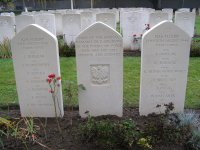
The view of the section at Rakowicki Cemetery (photos: Alexandra Dzieniecka, Aleksander Gucwa)
There are monuments and commemorative plaques in the places where the planes were shot down.
After Praga district was taken over on 13th September 1944, the planes of the Soviet Night Bombers' Squadron and the Polish 2nd Regiment of the Night Bombers "Kraków" commenced airdrops. The airdrops were carried out by small and light U-2 biplanes. The engine turned off, they would hedgehop over an airdrop location and dispatch the packages with supplies from a small height, often without a parachute. This method would result in the weapons and ammunition getting damaged and thus ending up useless. Sometimes even the cans with food would get damaged. We can assume that, in a way, they were sham operations.
During the conference of the Allied Ministers of Foreign Affairs, which took place in September 1943 in Moscow, the American raised an issue of pendulous flights. The idea was to make the American planes setting off from English airports land at the airports in Russia after they bombed the strategic targets. Once they refuelled there and replenished their bombs and ammunition, they would once again bomb the set targets on their way back. Despite the obvious advantages of this strategy, the Russian agreed to it only in the middle of the year 1944.
Two bases for American bombers were set up in Russia, in Poltava and Mirgorod, as well as one in Pyriatyn for fighter planes. There were altogether 23 flight operations carried out within the "Frantic." The Italian bases were a starting point for the planes 9 times, English ones - 4 times, while Russian - 10 times.
The operation "Frantic 1" began on 2nd June 1944, with Italy as a starting point, and having bombed the Debreczen marshalling yard the planes landed in Russia. Then they bombed the airfields in Galacz, Romania. "Frantic 1" ended on June 11th with the bombing of the airfields in Focsani, Romania, after which the armada came back to the Italian bases in Apulia.
On 21st June 1944, the American planes setting off from the bases in England began operation "Frantic 2," bombing industrial towns near Dresden and Biała Podlaska. In June they flew over Warsaw at a height of over 6,000 m - all you could see were the silhouettes of the planes catching sunlight. After the operation the planes landed at three bases: Poltava, Mirgorod and Pyriatyn. The results of the expedition were disastrous.
The planes were watched by a group of German spotter planes that established where the American planes landed. At the night of 21st/ 22nd June, the German launched a two-hour attack on the airport in Poltava, and then, at the night of 22nd/ 23rd June - in Mirgorod. 53 bombers B-17 and 3 fighters were destroyed as a result. The Russian anti-aircraft defence was poor; they didn't use their fighter planes and forbade the American "Mustangs" to take off.
After months of endeavour, on 12th September 1944 the Soviet Union authorities agreed to the American operation "Frantic 7" designed for Warsaw. The operation was set for September 14th, but it was cancelled due to a heavy fog. On September 15th the armada took off, but it was called back after an hour because of deteriorating weather conditions.
Finally, on September 18th at 6.20 am 110 bombers B-17, the so-called "flying fortresses" of No. 3 Squadron of 8 American Air force Army, took off from the airfields in the east of England. Colonel Pilot Karl Trusdell was in command.
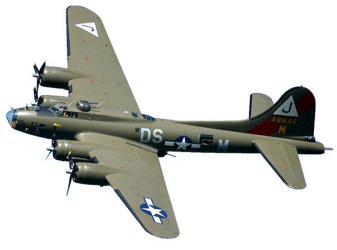
A bomber B-17 "Flying Fortress"
Technical data: 4 radial 9-cylinder Wright 1820-97 engines, power 1,200 KM (883 kW) each; dimensions: wing span 31.60 m, length 22.50, height 5.80, wing area131.9 m2; empty weight 16,374 kg, operational weight 29,710 kg; performance: maximum speed 486 km/h, cruising speed 380 km/h, rate of climb 4.6 m/s, ceiling 10,850, typical range 3,219 km, max range 5,470 km; weapons: 13 machine guns M-2 Browning 12.7 mm (movable, 4 of them twin-guns, located in the front, upper, lower and rear parts of the fuselage as well as at two wing positions in the fuselage), bomb load: 7,985 kg in the bomb bay in the middle part of the fuselage; crew: 10-11 members.
20 minutes earlier the "Mosquito" plane started - it led the expedition and identified the weather before it landed in Poltava.
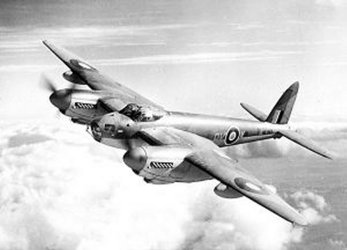
A British spotter plane "Mosquito"
Technical data: 2 Rolls-Royce Merlin engines 76.1680 KM (1253 kW) each; dimensions: wing span 16.51 m, length 12.44 m, height 4.65 m, wing area 42.18 m2;empty weight 6,490 kg, operational weight 9,070 kg; performance: maximum speed 595 km/h, rate of climb 670 m/min, ceiling 10,500 m, range 3,065 km; maximum range 5,470km, weapons: 4 Browning machine guns 7.7 mm or 4 Hispano-Suiza cannons calibre 20 mm or 450 kg of bombs, crew 2 members.
The operation was covered by 154 fighter planes P-51 "Mustang."
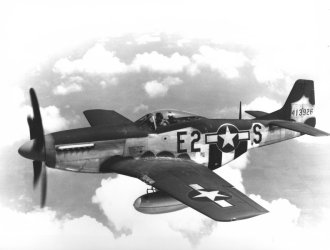
An American fighter plane P-51 Mustang
Technical data: 12 cylinder Allison engine V1710-81, 1,200 KM (883 kW) each; dimensions: wing span 11.27 m, length 9.82 m, height 3.70 m, empty weight 2,918 kg; operational weight 4,082 kg; performance: maximum speed 628 km/h, ceiling 955 m, range 563 km; maximum range 4,104 km; weapons: 4 machine guns 12.7mm, bomb load 453 kg, crew: 1 pilot.
Warsaw seemed abandoned and left to its own devices. Still, it should be remembered that at the time the fighting in Normandy was still in progress and the outcome was uncertain. It was not until August 8th that the Falaise Gap was closed and it could be finally assumed that the German troops in France had been destroyed and that the scales turned it the Allies' favour.
At the time when the American expedition consisting of 266 planes -110 Superfortresses B-17 and 156 Mustang fighters - started, the preparations for the Arnhem operation that had begun on September 17th were in progress, and they required a colossal number of aircraft and airport service.
It's worth mentioning how complicated in terms of logistics the American expedition of September 18th from England to Warsaw really was.
Each plane was loaded with 11 tons of fuel, 3 tons of containers, over a tone of ammunition for machine guns, and the crew amounted to 10-11 people. To provide service for 110 bombers and 156 fighters they needed a large body of maintenance personnel. Almost 5,000 people attended to the bombers and 500 to the fighters. Altogether there were 5,500 people working on the ground so that the expedition could take place, as well as 1,400 airmen in the air.
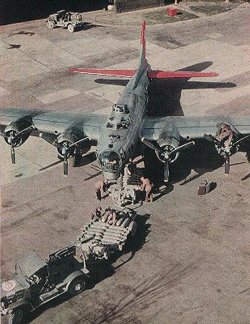
Getting a B-17 ready for a raid
In 1939, the joined forces of all Polish flights were not strong and numerous enough to soar to Warsaw's aid. On September 1st, the Polish air forces had 86 bombers and 160 fighters at their disposal.
The route of the armada went from Southwold over the North Sea near Schleswig, then by a Danish town of Maribo on Lolland Island, then along the Baltic Sea. They crossed the coast north to Koszalin and from there they flew over Chełmno to Warsaw. The route was 1,360 km long and B-17 planes covered it in 5 hours.
90 American fighters turned back over Denmark and near Kołobrzeg and flew back to England, engaging in the air battles and destroying many Derman planes at the Jagel airfield as they went. 64 Mustangs of No. 354 Fighter Group covered bombers B-17 on their way to Warsaw and further to the Russian airports. Three bombers B-17 had to turn back due to some technical problems.
107 planes continued their flight from the Baltic shore near Kołobrzeg through Toruń and Płock to Warsaw. 40 km west of Warsaw about 40 German fighters attacked the formation. The Mustangs picked up a fight, shooting down 4 Messerschmitts Bf 109 and damaging 3 more while losing two of their own planes.
The expedition did not encounter any German anti-aircraft defence on the way. Only when approaching the Łomianka-Dąbrowa region, they found themselves under fire which, while not very effective, increased as they made their way over the town. They counted 45 heavy cannons 88 mm.
As they approached Warsaw, one of the bombers B-17 was hit by a shell and exploded at about 12.46 near Pelcowizna. 7members of the crew were killed, 3 jumped with parachutes and were taken prisoner. One of them, having landed with a broken leg near the village of Dąbrowa-Dziekanów, was briefly interrogated by the German and then shot.
Anti-aircraft artillery damaged a number of B-17 planes. The pilot of one of the planes was killed; two members of the crew got injured. The co-pilot got the damaged machine to the base in Mirgorod, where the fallen pilot was buried.
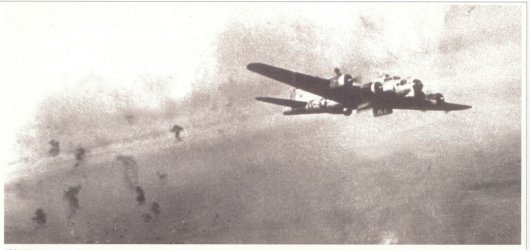
The Flying Fortress B-17 over Warsaw, shells of anti-aircraft artillery exploding in the background
The American planes were to drop the containers in three different places: Mokotów, Żoliborz and Sródmieście. The exact locations were marked with white, a hundred metres long sheets spread over the roofs and streets.
At about 12.30 the ten-minute-long airdrop started; the containers were dropped from a height of 5,200 - 4,200 m. Those watching from the ground thought at first that it was a paratroop drop. Numbers of colourful parachutes painted he sky. It aroused enthusiasm among the insurgents and an increased artillery fire on the part of the German.
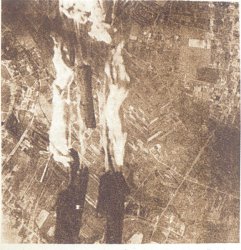 Mokotow |
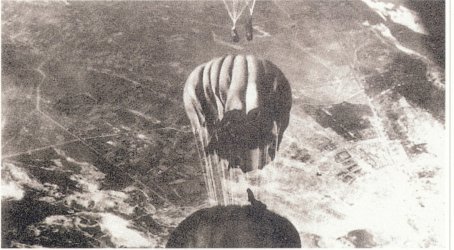 Zoliborz |
The airdrop over Warsaw districts, a characteristic layout of the streets visible below
The containers scattered over a large area. From 1,284 containers that were dropped only 228 ended up in the hands of insurgents. Many of them landed on a "no man's land," some were taken over by insurgents during the fights, others remained there. 28 containers were destroyed in artillery fire. Over 70 % of the airdrop load was taken over by the German. A dozen or so landed on the bank in Praga district, where Soviet and Polish troops were stationed.
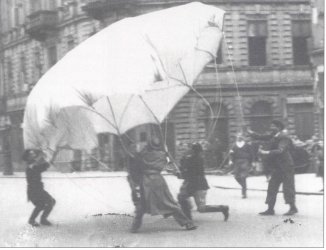
The folding up of an airdrop parachute
The airdrop supplies included 29,876 Sten machine guns, 390 Bren hand machine guns, 102 PIAT launchers and 2,200 grenades as well as 2,490 Gammon anti-tank grenades, 7,865 kg of plastic, 3.2 tons of fuse, 2.2 millions of ammunition items and 4,390 various grenades. There were also 12 containers filled with medical supplies and sanitary equipment for the insurgent field hospitals.
Although the result of the American operation was not as great as it was expected, it still proved a success when compared to the losses sustained during the night flights when 10 tons of the supplies equated one lost bomber. I the case of "Frantic-7" the losses had been expected to amount to 40 % while in fact only one B-17 and 3 Mustang fighters were lost.
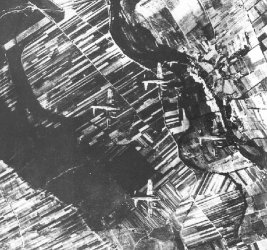
B-17 after an airdrop over Wilanów
After 11 hours the"Frantic-7" expedition returned to the airports in Russia. Bombers B-17 landed in Poltava and Mirgorod while Mustang fighters headed for Pyriatyn. On September 19th, after tanking up and replenishing ammunition and bomb loads, the planes continued on to their airports in England, bombing the railway junction and industrial plants in the town of Szolnok, Hungary as they went.
The next operation - "Frantic-8" - was planned for the end of September. It didn't take place because of the lack of consent from the Russian and the end of the insurgents' fighting.
It should be emphasized here that the crews of the RAF and SAAF displayed an admirable heroism. Regardless of their great losses, the Allied pilots never refused to come in aid of the fighting Warsaw. The Polish No. 1586 Flight was given an honourable title of "Warsaw Defenders."
The airdrops didn't have a significant influence on the outcome of the Warsaw Uprising. They were not potent enough, especially in the first phase of the uprising when the need for weapons and ammunition was direst. The airdrops in the Kampinos area were in fact a sham help for the insurgents since the region was virtually cut off from the capital city. Marshal Slessor, the MAAF Commander, was against sending the British aircraft to Warsaw since he believed it to be the field of Soviet operation. It coincided with the general opinion of the western superpowers carrying out the agreements of Teheran and Yalta.
Apart from fighting the airdrop planes flying to Warsaw with a ferocious artillery fire, The German also tried to influence the attitude of the insurgents by repudiating the pilots' endeavours. That's what the leaflet dropped by German planes over the insurgents' locations said:
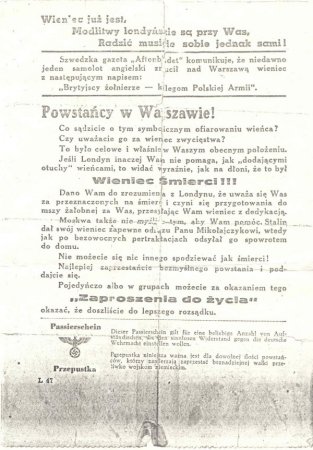
A German leaflet concerning airdrop operations
As follows from the contents of the leaflet, it was designed to not only disparage the efforts of the pilots but also to serve as a pass for the insurgents who would want to surrender. As could be expected, this kind of propaganda failed to influence the attitude of Polish soldiers and the urge to surrender resulted in nothing more but an ironic smile.
The attitude of the RAF and SAAF pilots was markedly different from that of higher rank commanders and politicians. With their heroism and sacrifice they gave example of brotherhood and loyalty in relation to their Polish brothers in arms - both those fighting on the streets and in the air.
The data below illustrate the efforts of pilots coming to the aid of Warsaw in August and September 1944.
The SOE forces carried out 196 flights in that period of time: Polish No.1586 Flight of the PAF - 91 flights, Squadrons No. 148 and 178 of the RAF - 59 flights, Squadron No. 31 of the SAAF - 55 flights.
There were 115 airdrops carried out over Warsaw, Kampinos and Kabacki Forest: the PAF - 78 airdrops, the RAF and SAAF - 40 airdrops; 74 of them were carried out directly over Warsaw.
The SOE planes dropped altogether 870 containers, 427 of which were delivered directly over Warsaw. The Home Army soldiers took over 514 containers, 235 of them in Warsaw.
The American operation "Frantic-7, " which took place on 18th September 1944, consisted of 110 bombers and carried out 107 airdrops. 1284 containers were dropped over three Warsaw districts, and the insurgents took over 228 of them.
During the period of support for Warsaw the SOE forces lost 39 planes: the PAF - 18 planes (Polish Flight), the RAF -12 planes, the SAAF - 8 bombers.
36 crews were lost after the planes were shot down: Polish No. 1586 Flight PAF lost 16 crews, the RAF - 11, and the SAAF - 9.
In the American operation Frantic-7 the losses amounted to 2 bombers B-17 and one crew.
2,472 people took part in the operations: the Polish in the number of 637, the British and the South -American - 735, the American - 1,100.
256 pilots of the Allied forces were shot down: 112 Polish airmen, 133 British and South-African ones, and 11 Americans. 41 of the shot down pilots survived.
One cannot but notice the extensive losses of the SOE airmen amounting to almost 20% of all losses. It bears evidence to how difficult their tasks were and how determined the crews to carry them out.
When analyzing such number data, one should feel the respect for the Polish pilots who, with the use of one Flight only, carried out as many operations as three or - at some point - even four squadrons of the RAF and SAAF forces.
From among the South-American pilots taking part in Warsaw airdrops 40,000 were killed. 11 of those who survived fatal flights are still alive. They commemorate the September days in grand style, revering the memory of those who fell. In 2006, a few Warsaw insurgents, who several decades earlier had watched in joy and pain the containers filled with weapon falling from the sky and the burning planes of those who came to their aid, were invited to Johannesburg. Among the invited quests were General Ścibor Rylski and Edmund Baranowski, both the members of "Radosław" group. The ceremony was truly magnificent: the laying of flowers by the commemorative plaques on the hill near Johannesburg was followed by a fly-past of the planes remembering the War. A huge bomber B-17 flew among them, surrounded by fighter planes.
In the summer of 2006 - the 62nd anniversary of the outbreak of the Warsaw Uprising - a Flying Fortress B-17 "Sally B" landed at the Okęcie airport. It was one of the two machines of this kind flying to Warsaw. On July 31st, the residents of Warsaw had a chance to admire the plane identical to the ones that on 18 September 1944 had carried out airdrops for the fighting city. On 1st August 2006, at 4 pm, "Sally B" took off from the Okęcie Airport and, circling over Warsaw, it dropped 50,000 leaflets encouraging the residents to stop at 5 pm and commemorate those who 62 years earlier had fought for the freedom of the country with a minute's silence.
Below we present a series of photos depicting the flying fortress that were taken by Andrzej Dulski, a member of the Legia Fans' Club.
For further information on the Allies' help for the fighting Warsaw in 1944 you might want to read the following works:
- Kajetan Bielecki. Lotnicze wsparcie Armii Krajowej. Arcana, Kraków, 1994.
- Jerzy Pawlak. Nad Warszawą - Warszawskie Termopile 1939 i 1944. Askon, Warszawa, 2000.
- Neil Orpen. Airlift to Warsaw: the Rising of 1944. Świat Książki, Warszawa, 2006.
prepared by Maciej Janaszek-Seydlitz
translation by: Agnieszka Rak
Copyright © 2009 Maciej Janaszek-Seydlitz. All rights reserved.